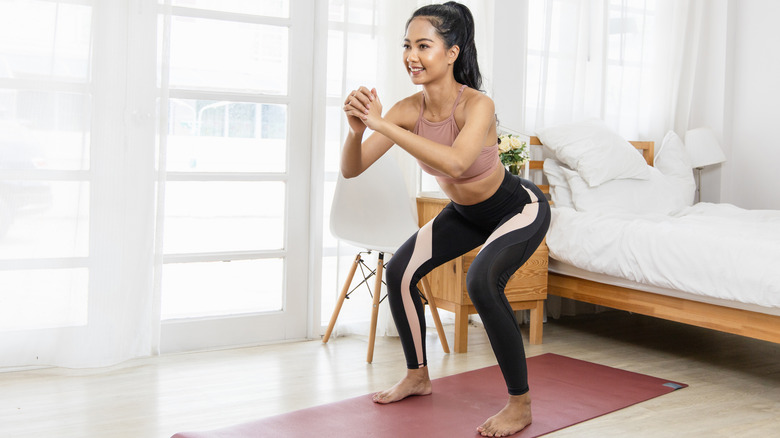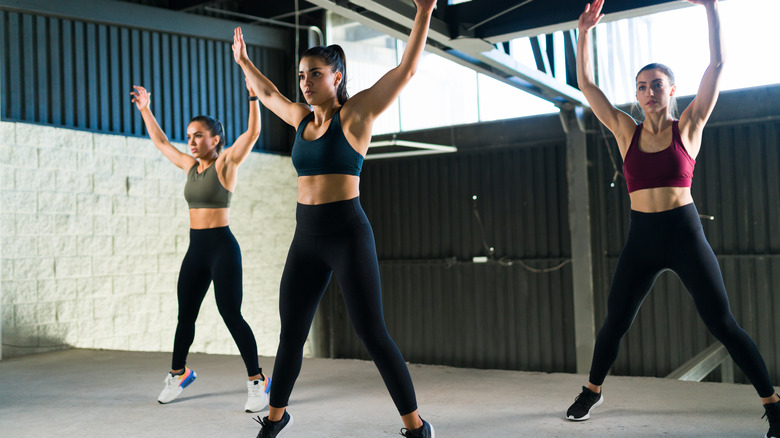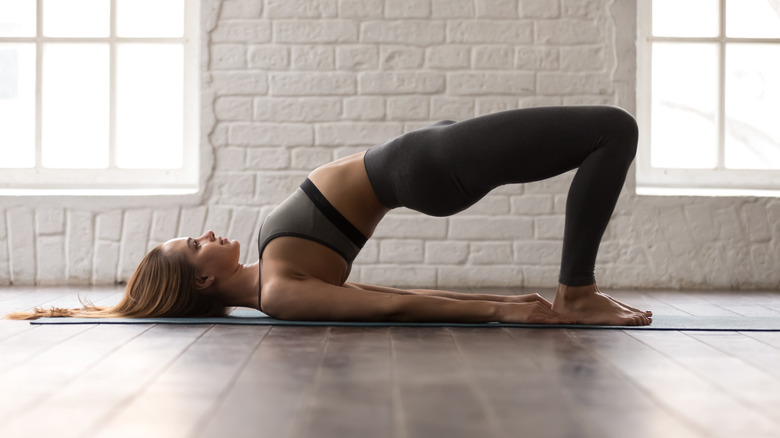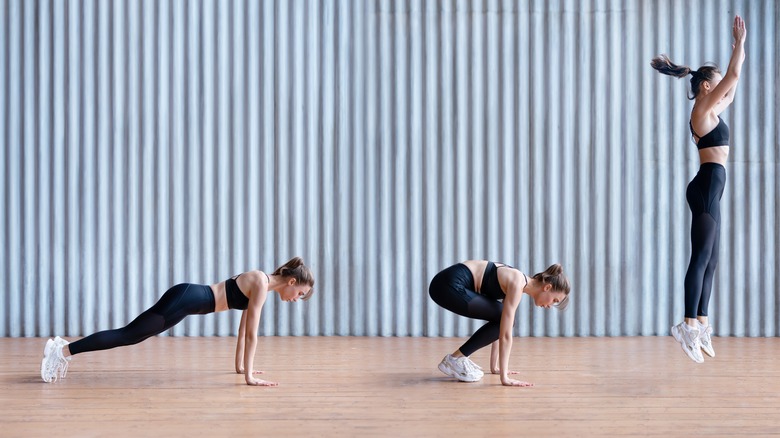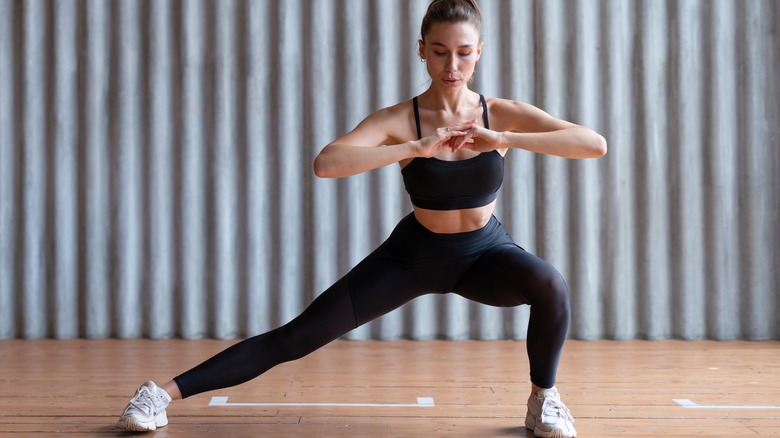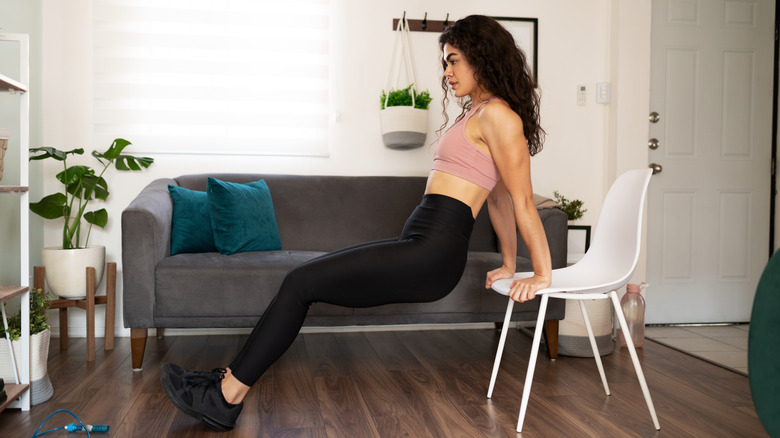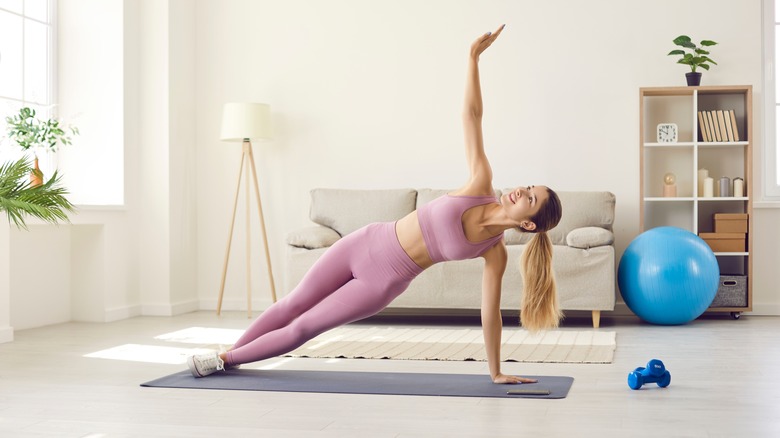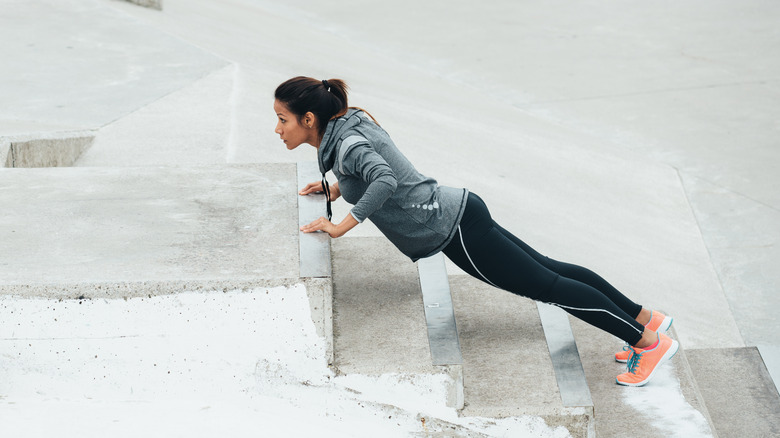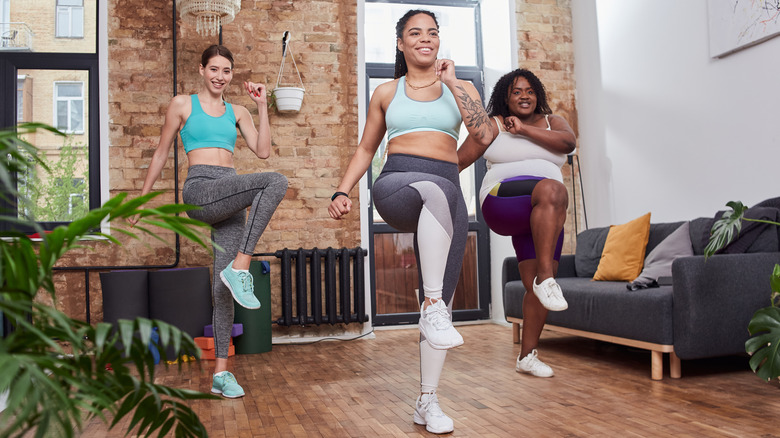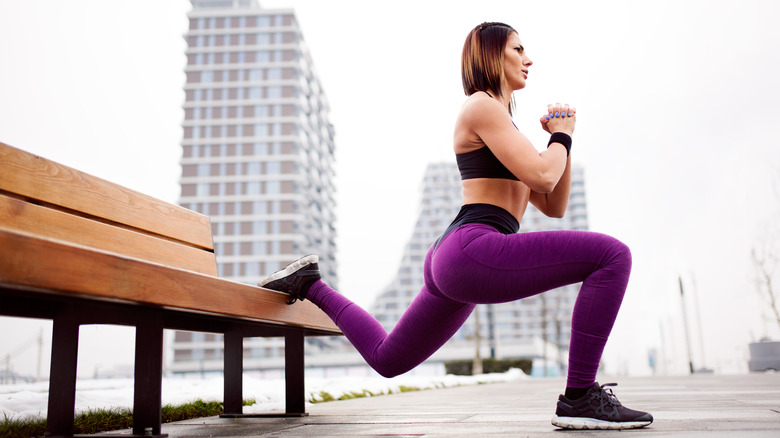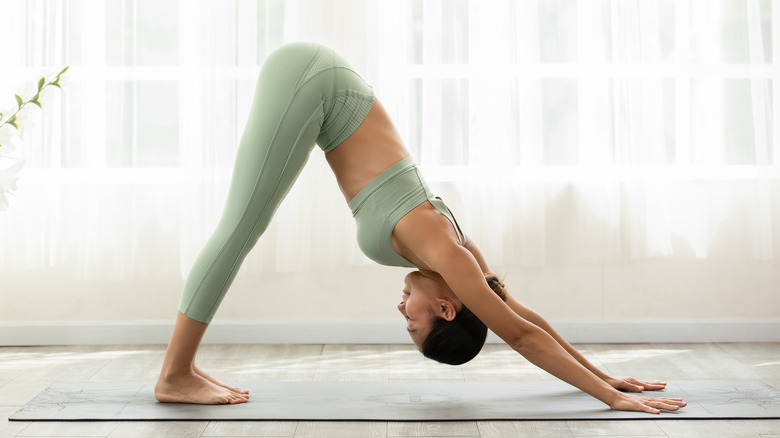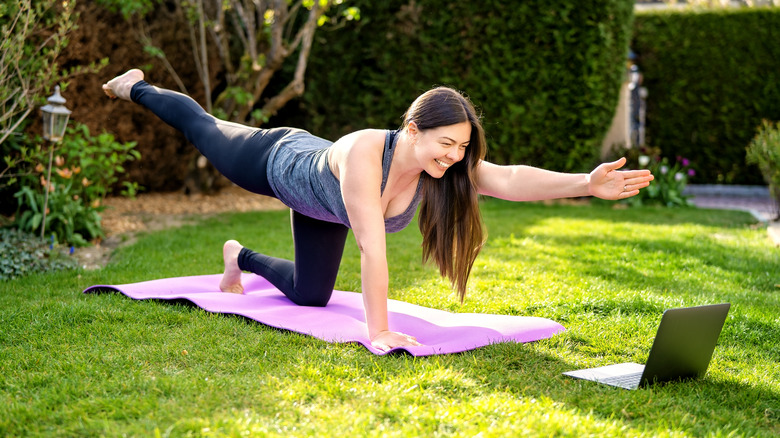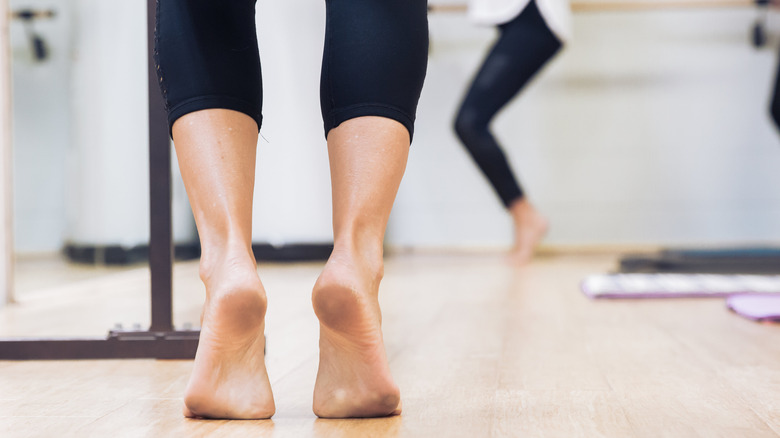12 Quick And Easy At-Home Workouts For You To Try
We may receive a commission on purchases made from links.
More people are gravitating toward quick and easy at-home workouts in an effort to improve their overall health without spending money on pricey gym memberships and equipment. While kettlebells, resistance bands, and squat racks certainly have their place for building strength and toning muscle, they aren't necessary to achieve the results you're looking for. Bodyweight training gets similar results to the use of gym equipment and can be done from wherever you're working out (via Mayo Clinic).
According to Harvard Health, bodyweight workouts provide a powerful type of resistance to help improve aerobic capacity, muscle endurance, and flexibility. Bodyweight workouts also target different muscle groups for a better full-body workout. They don't have to take up hours of your day either. A 2021 study published in the International Journal of Exercise Science found that simple bodyweight exercises enhanced overall fitness levels even in a short amount of time. This is because quick at-home workouts are normally done in a circuit style with limited rest periods, getting the heart pumping and the muscles working hard.
There are endless possibilities for effective at-home workouts that will challenge your body but aren't difficult to execute. They are also convenient for busy, modern women to fit into their schedules. Whether you want to increase flexibility, strengthen your core, or tone up your glutes, these 12 quick and easy at-home workouts are guaranteed to help you crush your fitness goals.
The importance of warming up and cooling down
Before starting any at-home workout, it is vital that you warm up. "Stretching allows for greater range of motion and eases the stress on the joints and tendons, which could potentially prevent injury," director of the Asian Heart Initiative at New York University, Johnny Lee, M.D., tells the American Heart Association. "Warming up, such as low heart rate cardio, prepares the circulatory and respiratory system for the upcoming age-and-type appropriate target heart rate exercising, whether it's endurance or sprint type of activities." A warm-up needn't take more than 10 minutes total and should combine light aerobics with stretching.
Popular starter exercises include jogging in place, jumping rope, jumping jacks, and butt kicks, all of which contribute to better cardiovascular health. To loosen up your muscles, a mix of static and dynamic stretching is ideal. Static stretches focus on a particular muscle and require holding the position for 15 to 20 seconds. This type of stretching is great for lengthening the muscle and helps prevent acute muscle strain, per Physiopedia. Dynamic stretching is more popular for a starter exercise, as it gives the joints and muscles a preview of the action you're preparing for (via Healthline). Walking lunges, side bends, and arm circles are all excellent dynamic stretches to incorporate into your at-home workout routine.
When you're finished, a 5 to 10 minute cool-down is ideal for optimal recovery, preventing lactic acid from building up in the muscles, and reducing discomfort the next day.
Beginner bodyweight workout
Beginners in need of a quick at-home workout should look for exercises that work the full body. Exercises like push-ups, planks, squats, stationary lunges, and hip bridges — also known as glute bridges — are basic, functional movements that are easy to master but provide plenty of intensity for people who aren't used to working out. Aim for 10 to 12 reps of each exercise in three rounds to start, with a 1 to 2 minute rest period in between each round. This pattern enables focus on the moves and helps you make every rep count (via Daily Burn). Remember to maintain form while you complete each exercise. If you aren't sure how to properly perform an exercise, consult free online demos from a licensed personal trainer or exercise professional.
Over time, your strength will increase and your body will get used to the exercises in this beginner-friendly workout. According to Nerd Fitness, you can mix it up by adding more reps, shortening rest periods, or performing each rep slower. This will also keep the workout fresh and exciting for a long time.
High-intensity interval training workout
According to the American College of Sports Medicine, a high-intensity interval training (HIIT) workout, is a popular form of exercise with many health perks. It involves brief bursts of high-intensity exercise rounds with short rest periods in between. A round normally lasts between 5 seconds to 8 minutes total. In a HIIT workout, the goal is to perform at between 80% to 95% of your max heart rate. This method often burns off more calories than traditional workouts, with the ability to reduce abdominal fat and retain muscle. HIIT workouts can be modified for different fitness levels and abilities, however, in an at-home setting, it is better suited for people with prior workout experience.
Bodyweight HIIT workouts are normally performed in a timed circuit, with a goal to complete as many reps of each exercise as possible in the allotted time period (via Fitbod). A full body HIIT workout can be done with a combination of burpees, mountain climbers, jump squats, and pushups. Burpees, which combine a squat, jump-back, plank, push-up, and a jump forward, are a powerful movement that will increase your heart rate and challenge the muscles, per The Washington Post. Incorporating them into your at-home HIIT workout alongside other tough bodyweight moves is a surefire way to get into shape fast. Due to the exhaustive nature and long recovery periods required with HIIT workouts, start with one workout a week and gradually build up to two.
Lower body workout
You can get a great lower body workout in only 20 minutes. Simply combine glute bridges, squats, lateral lunges, and single leg deadlifts in a quick circuit to strengthen the legs and butt. Perform three rounds of 10 to 12 reps a few times weekly.
While these lower body exercises are easy to execute, there are some form issues you should keep in mind. For example, a proper bodyweight squat requires standing with your feet a little wider than your hips and your toes facing out a bit. You should keep your weight in your heels and your core flexed as you squat down with your knees in line with your feet (via Nerd Fitness). A glute bridge is an effective lower body exercise that activates the glutes and helps increase core stability, per NASM. To perform this exercise, lay on your back with your knees bent, placing your heels roughly 8 inches away from your glutes. Raise your hips towards the ceiling without arching your back, squeeze your glutes at the top of the movement and hold for two seconds. Then, lower your hips in a controlled motion.
According to Women's Health, a lateral lunge requires balance while keeping your knee in line with your toes and sitting back into the lunge so your working leg forms a 90-degree angle. To do a single leg deadlift, put your weight on one leg while leaning forward at the hips and extend your non-working leg behind you.
Upper body workout
Strengthening your shoulders, biceps, and triceps without equipment may seem impossible. The reality is, you can get in a challenging at-home upper body workout using only your bodyweight and your living room floor. Some of the best arm and chest exercises include mountain climbers, bear crawls, and tricep dips.
Mountain climbers are a great full body exercise that helps build strength in the shoulders and arms. To perform these exercises, put both hands on the floor and extend your legs behind you in a plank position. Bring one knee up to your chest, switching legs in one smooth motion, per The New York Times. Bear crawls also require starting on all fours and lifting your knees so they hover above the ground. According to ClassPass, you move one hand and the opposite leg forward in a crawling motion, while keeping your knees hovering above the ground. The move works your core, glutes, and chest in addition to your upper arms. Tricep dips, also known as chair dips, focus on the triceps but also strengthens the shoulders and upper arms (via Verywell Fit). Using a bench or stable chair, place your palms flat on the object and shift forward so that your butt clears the edge. Lower yourself until your elbows are bent at roughly 90-degree angles, and then push yourself back up with a controlled motion.
Combine all of these exercises in 3 to 5 rounds. To challenge yourself, perform each exercise for 60 seconds.
At-home ab workout
Core exercises help improve overall balance and stability while also toning the abdominal muscles. According to Mayo Clinic, these exercises don't require any equipment to execute, and can help you reach your fitness goals much faster. Despite this, many people don't incorporate ab workouts into their fitness routines, citing a lack of time or a dislike of crunches. However, at-home ab workouts don't necessarily require crunches. Focus instead on a circuit that includes moves like side planks, toe touches, or knee-to-elbow planks for a complete core workout.
Side planks are an easy move that will fire up the obliques, or side abdominals. Simply lay on your side with your elbow under your shoulder and your feet stacked on top of one another. Work the core to lift your hips up, holding the position for 30 seconds per rep (via Women's Health). Toe touches are similar to sit-ups in the way they work the lower ab muscles. To perform this move, lie on your back with your legs lifted towards the ceiling and toes pointed. Use your core to lift your upper body towards your toes, tapping your feet or ankles with your fingers before returning to the floor.
Knee-to-elbow planks are a challenging plank variation that works the entire core but targets the obliques. Get into a high plank position and start by bringing your left knee outside of your left elbow. Repeat with the right knee and come back to high plank for one rep.
Shoulder workout
A quick and easy at-home shoulder workout you can do with just your bodyweight should include incline pushups and plank to downward dog. These moves target the deltoids and pectoral muscles in the chest, but build strength in other upper body muscles as well.
According to Bodybuilding, incline pushups are a variation of the exercise that require elevating the hands to put your body at an angle with the floor. Simply place your hands shoulder width apart on a sturdy chair or weight bench. Keep your arms perpendicular to your body as you lower down to the bench and then slowly push yourself back up. Incline pushups are great for beginners who can't perform a traditional pushup as it helps build strength and hone form. Aim for 10 to 12 reps each round to start.
A plank to downward dog looks easy, but it will strengthen the shoulder muscles in no time (via Healthline). Starting in a high plank position, lift the hips towards the ceiling and transition to a downward dog yoga pose. Your arms and legs should be straight, forming an upside-down V-shape. Return to high plank and repeat for 10 to 12 reps.
Cardio workout
Contrary to popular belief, you do not need a treadmill, elliptical, or stationary bike to get in a good at-home cardio workout. You can get the heart pumping and sweat dripping with nothing more than your own body and the help of a few bodyweight cardio exercises. Exercises like burpees and mountain climbers are fantastic for building muscle strength while also improving cardiovascular health. You should also try incorporating exercises like high knees and ice skaters into your routine to go the extra mile. When performing at-home cardio exercises in your workout, aim for time rather than individual reps.
High knees are excellent for strengthening the hip flexors, glutes, quads, and working the core (via BarBend). This high intensity movement has a much lower impact on the joints compared to traditional cardio exercises such as running. Simply run or skip in place, bring your knees to your chest and keep your arms at 90-degree angles.
Ice skaters, or skater jumps, work the muscles of the lower body and involve explosive lateral jumps. Stand on one leg with the other leg bent at the knee and jump to the side, landing on the other leg (via Exercise). Repeat over and over, focusing on controlled movements.
Glute-focused workout
You can build the butt of your dreams with a quick, at-home glute-focused workout. While a strong posterior is aesthetically pleasing, it is incredibly important for helping you stand and complete everyday movements (via Methodist). Whether your goal is to have the booty of a Kardashian or to simply make functional movements easier, exercises like jump squats, Bulgarian split squats, and curtsy lunges are all great additions to a lower body workout.
Jump squats are an excellent cardio and strength building movement that helps burn fat, per Bodybuilding. Simply sink down into a normal squat and, pressing with the balls of your feet, jump into the air with as much force as possible. When you land, transition immediately into a squat. Repeat for the desired amount of reps.
Bulgarian split squats and curtsy lunges will also get your heart pumping and your legs burning but without the jumping. According to Coach, Bulgarian split squats require elevating your back foot, which places the weight on your front leg when you dip into a squat. It is also a great movement for strengthening the quads and butt. Curtsy lunges target the gluteus medius and gluteus minimus, giving it a rounder look, per Anabolic Aliens. To perform this exercise, step your right foot back and to the left while squatting down in a curtsy-like motion. Come back up to standing and repeat on the other leg.
Full-body yoga workout
Incorporating yoga into your at-home workout routine is an ideal way to boost muscle strength and build endurance without equipment (via Nike). It increases flexibility, tones muscles, improves cardiovascular and circulatory health, and can lessen chronic pain. Yoga can assist with other types of workouts by improving mobility and balance. Yoga has also been proven to be a better form of exercise than traditional strength training because it can be adapted for individuals of all fitness levels and abilities.
According to the American Osteopathic Association, a regular yoga practice is also beneficial for your mental health. The meditation and breathing aspects of yoga are ideal for minimizing stress, focusing concentration, and helping you become more self aware. It is a powerful tool for improving mood as well, releasing endorphins and increasing oxygenated blood flow to your brain, per Harvard Health Publishing.
Although yoga isn't likely to build muscle, it has superb physical and mental benefits that are ideal for any at-home fitness routine. If you don't want to pay for an in-person class, free full-body yoga workouts can be found online.
A core-focused pilates workout
Like yoga, pilates is a form of exercise that conditions the entire body to strengthen and tone muscles, while improving flexibility, per Cleveland Clinic. It is a gentle but challenging workout that helps bring more awareness to the body through mind-body connection, while simultaneously supporting the aches and pains that come from sedentary lifestyles. Pilates can work any area of the body, but it is primarily used for core strength.
According to Today, pilates exercises focus on small, precise movements that engage the core muscles and increase stability. Toe taps are a great example of this. They involve lying on your back with bent knees and your feet flat on the ground. Drawing your navel in toward your spine, bring both knees up so your shins face the ceiling. Keeping your upper body still and engaging your core, drop one toe to the ground and slowly raise it back up. Alternate legs until you've performed 20 to 30 taps on each leg.
The Pilates 100 move is another excellent way to strengthen the core. To perform this move, lie down and lift your legs up to a 45-degree angle. Lift your upper body off of the floor and extend your arms straight out on either side of your legs. With your palms facing the ground, begin pulsing your arms up and down 100 times, taking care to control your breathing and engage the core.
At-home barre workout
The popularity of barre workouts has sky rocketed over the past decade. It is a simple form of low-impact, effective exercise that increases flexibility and tones through tiny, muscle-isolating movements (via Los Angeles Times). The hybrid workouts combine elements of yoga, pilates, and ballet to elongate the muscles, improve posture, and strengthen the core. Although barre workouts can be done in classes or using resistance equipment, they can also be performed from the comfort of home with only bodyweight. Use a stable, high-back chair in lieu of a ballet bar.
A parallel plié pulse requires holding on to the back of your chair with knees and feet together. Press up onto the balls of your feet and lower into a deep plié. With your knees bent and your feet together, come up halfway and begin pulsing (via Shape). This movement works the glutes, quads, feet, ankles, and core.
To perform a plié port de bras, stand with your feet in second position and bend your knees out over your toes. Scoop your arms in front of your chest with your palms facing up, keeping a slight bend in the elbows. Bring your arms out on either side of your body into second position and then bring them overhead into third position. Reverse the movement and straighten your legs to come out of the plié. That counts as one rep.
